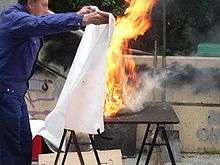Fire blanket


A fire blanket is a safety device designed to extinguish incipient (starting) fires. It consists of a sheet of fire retardant material which is placed over a fire in order to smother it.
Small fire blankets, such as for use in kitchens and around the home, are usually made of fiberglass and sometimes kevlar, and are folded into a quick-release contraption for ease of storage.
Fire blankets, along with fire extinguishers, are fire safety items that can be useful in case of a fire. These nonflammable blankets are helpful in temperatures up to 900 degrees and are useful in smothering fires by not allowing any oxygen to the fire. Due to its simplicity, a fire blanket may be more helpful for someone who is inexperienced with fire extinguishers.
Larger fire blankets, for use in laboratory and industrial situations, are often made of wool (sometimes treated with a flame retardant fluid). These blankets are usually mounted in vertical quick-release container so that they can be easily pulled out and wrapped round a person whose clothes are on fire.[1]
Dangers
Asbestos in old blankets
Some older fire blankets were made of woven asbestos fibers and are not NFPA rated. This can pose a hazard during the decommissioning of old equipment.
Extinguishing boilovers
After initial investigation in 2013, and later in 2014, the Netherlands Food and Consumer Product Safety Authority issued a statement that Fire blankets should never be used to extinguish a Boilover such as a chip pan fire, even if the icons or text on the blanket indicates the blanket may be used in such a case.[2][3][4] This includes fire blankets which have been tested according to BS EN 1869.[5] In the investigation out of the 22 tested fire blankets, 16 of the fire blankets themselves caught fire. In the other 6 the fire reignited when the blanket was removed after 17 minutes. The Dutch Fire Burn foundation reported[6] several accidents involving the use of fire blankets when extinguishing boilovers. Consumers may send in their existing fire blankets, which will then receive a sticker stating 'niet geschikt voor olie- en vetbranden' ("not suitable for oil- and fat fires"). New products will have this text printed, rather than stickered.[7]
Operation
In order for a fire to burn, all three elements of the fire triangle must be present: heat, fuel and oxygen.The fire blanket must be sealed closely to a solid surface around the fire. Whether the blanket is placed on top, or surrounding it, the job of the blanket is to cut off the oxygen supply to the fire, thereby putting it out.
Fire Blankets usually have two pull down tails visible from outside the packaging. The user should place one hand on each tag and pull down simultaneously removing the blanket from the bag.
The tails are located near the top of the fire blanket which allows the top lip of the fire blanket to fold back over the users hands protecting it from radiated heat or direct contact burns.
See also
- Welding blanket
- Fire proof
- Asbestos
References
- ↑ Fire Blanket Usage
- ↑ "NVWA - Niet alle blusdekens blussen olie- en vetbranden".
- ↑ "NVWA - Belangrijke veiligheidswaarschuwing: blusdekens niet geschikt voor frituurbranden".
- ↑ http://www.vwa.nl/txmpub/files/?p_file_id=2207490
- ↑ https://www.nvwa.nl/txmpub/files/?p_file_id=2204607
- ↑ "Vlam in de pan: niet blussen met een blusdeken". Nederlandse Brandwonden Stichting.
- ↑ "NVWA - NVWA controleert etikettering blusdekens".
External links
| Wikimedia Commons has media related to Fire blankets. |
.jpg)